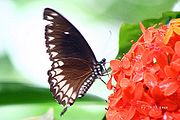
Papilio dravidarum
Encyclopedia
The Malabar Raven is a species of Swallowtail
butterfly found in the Western Ghats
of India
.
 The Malabar Raven is a blackish brown tailless swallowtail, about 80 to 100 mm in size. Both the sexes are similar and are mimics of the unpalatable Common Crow Euploea core
The Malabar Raven is a blackish brown tailless swallowtail, about 80 to 100 mm in size. Both the sexes are similar and are mimics of the unpalatable Common Crow Euploea core
. The upper forewing has a small white spot at the end of the cell, a complete series of equal sized marginal white spots in regular row and a terminal series of spots decreasing in size towards the apex. The upper hind wing has a discal series of arrowshaped white spots. It also has a submarginal series of elongated white crescent shaped markings. There is a white fringe between the veins. The outer halves of wings have a dusting of yellowish brown scales.
between 1000 to 3000 feet. It has been recorded in January and from March to October.
Swallowtail butterfly
Swallowtail butterflies are large, colorful butterflies that form the family Papilionidae. There are over 550 species, and though the majority are tropical, members of the family are found on all continents except Antarctica...
butterfly found in the Western Ghats
Western Ghats
The Western Ghats, Western Ghauts or the Sahyādri is a mountain range along the western side of India. It runs north to south along the western edge of the Deccan Plateau, and separates the plateau from a narrow coastal plain along the Arabian Sea. The Western Ghats block rainfall to the Deccan...
of India
India
India , officially the Republic of India , is a country in South Asia. It is the seventh-largest country by geographical area, the second-most populous country with over 1.2 billion people, and the most populous democracy in the world...
.
Range
Endemic to the Western Ghats in South India. It occurs in the states of Kerala, Tamil Nadu, Karnataka and Goa.Status
Uncommon but not known to be threatened. Commonest in Wynaad and Coorg in the past. Rarer towards the extremities of its range.Description

Euploea core
The Common Crow is a common butterfly found in South Asia. In India it is also sometimes referred to as the Common Indian Crow, and in Australia as the Australian Crow. It belongs to the Crows and Tigers subfamily of the Nymphalidae .The Common Crow is the most common representative of its genus...
. The upper forewing has a small white spot at the end of the cell, a complete series of equal sized marginal white spots in regular row and a terminal series of spots decreasing in size towards the apex. The upper hind wing has a discal series of arrowshaped white spots. It also has a submarginal series of elongated white crescent shaped markings. There is a white fringe between the veins. The outer halves of wings have a dusting of yellowish brown scales.
Habitat
This butterfly frequents heavy jungles of the Western GhatsWestern Ghats
The Western Ghats, Western Ghauts or the Sahyādri is a mountain range along the western side of India. It runs north to south along the western edge of the Deccan Plateau, and separates the plateau from a narrow coastal plain along the Arabian Sea. The Western Ghats block rainfall to the Deccan...
between 1000 to 3000 feet. It has been recorded in January and from March to October.
Habits
The Malabar Raven resembles the model Common Crow in habits and flight, but is faster than the other mimic, the Common Mime. It prefers shady patches. The males drink at wet patches especially in the hot dry pre-monsoon days. This butterfly does not visit flowers.Lifecycle
There are two to three broods a year. Recorded in Coorg as having broods from September to October, November to December, and, from April to May. Recorded in Karnataka in July and in September. Males appear to outnumber the females.Foodplants
- Glycosmis pentaphylla of the family RutaceaeRutaceaeRutaceae, commonly known as the rue or citrus family, is a family of flowering plants, usually placed in the order Sapindales.Species of the family generally have flowers that divide into four or five parts, usually with strong scents...
. Others that have been noted include Clausena heptaphylla.
Other sources
- Collins, N.M. & Morris, M.G. (1985) Threatened Swallowtail Butterflies of the World. IUCN. ISBN 2-88032-603-6
- Evans, W.H. (1932) The Identification of Indian Butterflies. (2nd Ed), Bombay Natural History Society, Mumbai, India
- Gaonkar, Harish (1996) Butterflies of the Western Ghats, India (including Sri Lanka) - A Biodiversity Assessment of a threatened mountain system. Journal of the Bombay Natural History Society.
- Gay,Thomas; Kehimkar,Isaac & Punetha,J.C.(1992) Common Butterflies of India. WWF-India and Oxford University Press, Mumbai, India.
- Kunte,Krushnamegh (2005) Butterflies of Peninsular India. Universities Press.
- Wynter-Blyth, M.A. (1957) Butterflies of the Indian Region, Bombay Natural History Society, Mumbai, India.

